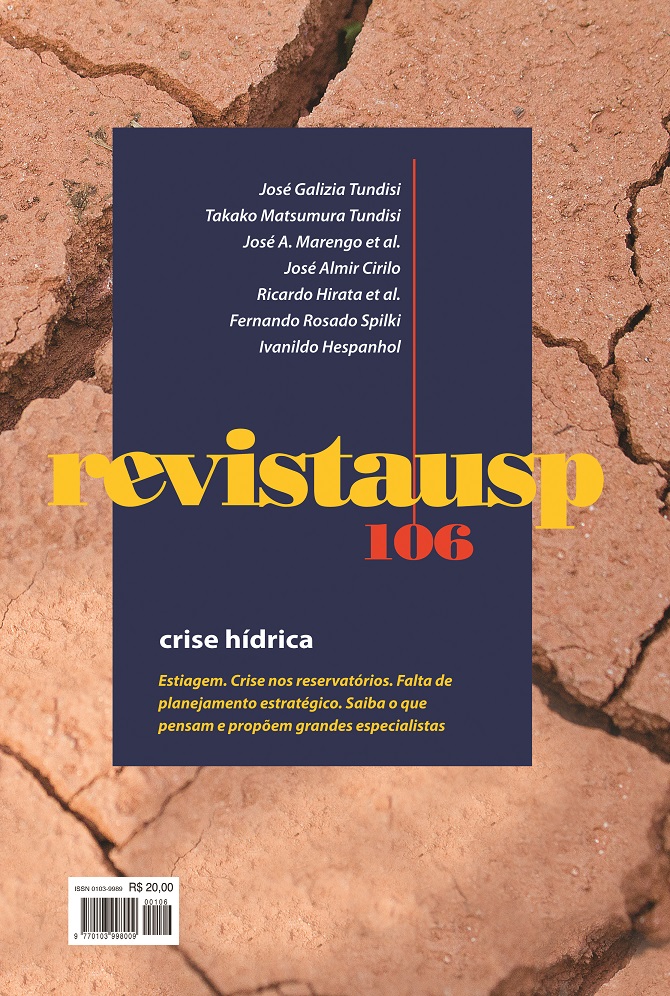As múltiplas dimensões da crise hídrica.
DOI:
https://doi.org/10.11606/issn.2316-9036.v0i106p21-30Palavras-chave:
crise hídrica, gestão integrada, segurança hídrica, qualidade da água.Resumo
Este trabalho apresenta uma avaliação global dos problemas complexos resultantes das crises hídricas. Além de análise e diagnóstico, propõe também soluções para o controle das crises, redução de riscos e gestão integrada com governança efetiva e participativa. Destaca as interações entre segurança hídrica, qualidade de água, disponibilidade de recursos hídricos e estabilidade social.
Downloads
Referências
ABC – Academia Brasileira de Ciências/ Die Junge Akademie/Leopoldina Nationale Akademie der Wissenchatten. Water in Urban Regions: Building Future Knowledge to Integrate Land Use, Ecosystem Services and Human Health. Berlin, 2014.
ANELLI, R. L. S. “Uma Nova Cidade para as Águas Urbanas”, in Estudos Avançados, v. 29(84), 2015, pp. 69-84.
BUCKERIDGE, M. “Árvores Urbanas em São Paulo: Planejamento Economia e Água”, in Estudos Avançados, v. 29(84), 2015, pp. 85-101.
CONFALONIERI, U.; HELLER, L.; AZEVEDO, S. “Água e Saúde: Aspectos Globais e Nacionais”, in C. Bicudo; J. G. Tundisi; M. Scheuenstuhl (orgs.). Águas do Brasil: Análises Estratégicas. Academia Brasileira de Ciências, Instituto de Botânica, 2010, pp. 27-38.
CORTES, L. P.; TORRENTE, M. “Crise de Abastecimento de Água em São Paulo e Falta de Planejamento Estratégico”, in Estudos Avançados, v. 29(84), 2015, pp. 7-26.
ELIASSON, J. “The Rising Pressure of Global Water Shortages”, in Nature 517(7532), 2015. Disponível em: http://www.nature.com/news/the-rising-pressure-of-global-watershortages-1.16622.
GOODFRAY, C. J. et al. “Food Security: the Challenge of Feeding 9 Billion People”, in Science, v. 327, 2010, pp. 812-7.
HESPANHOL, I. “Conservação e Reúso como Instrumentos de Gestão para Atenuar os Custos de Cobrança pelo Uso de Água no Setor Industrial”, in C. Bicudo; J. G. Tundisi; M. Scheuenstuhl. Águas do Brasil. Análises Estratégicas. Academia Brasileira de Ciências, Instituto de Botânica, 2010, pp. 59-80.
HIRATA, H.; ZOBY, J. L. G.; OLIVEIRA, F. R. “Água Subterrânea: Reserva Estratégica ou Emergencial”, in C. E. M. Bicudo; J. G. Tundisi; M. Scheuenstuhl (orgs.). Águas do Brasil: Análises Estratégicas. Academia Brasileira de Ciências, Instituto de Botânica, 2010, pp.149-61.
HUPFER, H. M.; FIQUEIREDO, J. A. S.; TUNDISI J. G. (orgs.). Pagamento por Serviços Ambientais. Porto Alegre, Entremeios, 2013.
JASNY, B. et al. “Global Health. What Works”, in Science, v. 345, issue 6.202, 2014, p. 1.256.
JACOBI, P. R.; CIBIM, J.; LEÃO, R. S. “Crise Hídrica na Macrometrópole Paulista e Respostas da Sociedade Civil”, in Estudos Avançados, v. 29(84), 2015.
JIMENEZ-CISNEROS, B. “Responding to the Challenges of Water Security: the Eighth Phase of the International Hydrological Programme 2014-2021”, in C. Cudennec et al. Hydrological Sciences and Water Security: Past, Present and Future. PIAHS 366, 2015, pp. 10-9.
LLAMAS, R.; MARTINEZ-SANTOS, P. “Intensive Groundwater Use: Silent Revolution and Potential Source of Social Conflict”, in ASCE Journal of Water Resources Planning and Management, 131(5), 2005, pp. 337-41.
McCLAIN, M. E; DU BOWY, P. J.; ZALEWSKI, M. “Ecohydrology for the Harmonization of Societal Needs with the Biosphere Potential”, in Ecohydrology & Hydrobiology, v. 13, 2013, pp. 3-5.
McNUTT, M. “The Drought You Can’t See”, in Science, v. 345, issue 6.204, 2013, p. 1.543.
MOSS, B. et al. “Synthesis and Conclusions to the International Symposium on Ecohydrology, Biotechnology and Engineering: Torwards Harmony between the Biogeosphere and Society on the Basis of Long-Term Ecosystem Research”, in Ecohydrology & Hidrobiology, v. 14(1), 2014, pp. 2-13
NAKAMURA, M.; RAST, W. “Development of Integrated lake Basin Management Process”, in Research Caster for Sustainability and Environment. Japan, Shiga University, 2011.
OGASHAWARA, I. et al. “Cyanobacteria Detection in Guarapiranga Reservoir (S. PauloBrazil) Using Landsat T. M. and ETM Images”, in Ambiente & Água, v. 9, n. 2. Taubaté, pp.1-14.
ROGERS, P. P. “Water Governance, Water Security and Water Sustainability”, in P. P. Rogers; N. Ranon Llanas; L. Martinez-Cortina (eds.). Water Crisis: Myth or Realty?. London, Fundación Marcelino Botín/Taylor Francis, 2006.
SCHEFFRAN, J. et al. “Climate Change and Violent Conflict”, in Science, v. 336, 2012, pp. 869-71.
TUNDISI, J. G. (coord.). Recursos Hídricos no Brasil: Problemas, Desafios e Estratégias para o Futuro. Estudos Estratégicos. Rio de Janeiro, Academia Brasileira de Ciências, 2014.
. “Cianobactérias e Qualidade da Água na Represa da UHE Carlos Botelho (Lobo/Broa)”, in Relatório ao Ministério Público do Estado de São Paulo, 2014.
. “Entrevista”, in Science, v. 347, issue 6.224, 2015, pp. 812.
TUNDISI, J. G. et al. “Water Availability, Water Quality, Water Governance: the Way Ahead”, in C. Ardenec et al. (ed.). Hydrological Sciences and Water Security: Past, Present and Future. PIAHS, 2015, pp. 75-9.
TUNDISI, J. G. et al. “A Bloom of Cyanobacteria (Cylindrospermopsis raciborskii) in UHE Carlos Botelho (Lobo/Broa) Reservoir: a Consequence of Global Change?”, in Brazilian Journal of Biology, v. 75, n. 2, 2015, pp. 507-8.
UNEP – United Nations Environment Programme. Marine and Coastal Ecosystems and Human Well-being: a Synthesis Report Based on the Findings of the Millennium Ecosystem Assessment. Nairobi, Unep, 2006. Disponível em: http://www.unep.org/pdf/Completev6_LR.pdf.
UN-WWAP (United Nations Water Assessment Programme) UN World Water Development Report 2: Water, a Shared Responsibility. Paris, New York and Oxford. Unesco (United Nations Educational, Scientific and Cultural Organization) and Berghahn Books. 2006. Disponível em: http://unesdoc.unesco.org/images/0014/001444/144409E.pdf.
UNESCO – United Nations Educational, Scientific and Cultural Organization. International Hydrological Programme – IHP. 20th Session of the Intergovernmental Council. Paris, June 2012. Disponível em: http://unesdoc.unesco.org/images/0021/002164/216434E.pdf.
VÖRÖSMARTY, C. J. et al. “Global Threats to Human Water Security and River Biodiversity”, in Nature, 467(7.315), 2010, pp. 555-61.
WATSON, R. T.; ZINYOWERA, M. C.; MOSS, R. H. (eds.). The Regional Impacts of Climate Change: an Assessment of Vulnerability. Intergovernmental Panel on Climate Change – IPCC. Cambridge University Press, 1998.
YOUNG, G. et al. “Hydrological Challenges and Water Security: an Overview”, in Hydrological Sciences and Water Security: Past, Present and Future. Proceedings of the 22th FOUACS Collegium. Paris, June, 2014, IHHS Publ., 2015, pp. 2-9.
Downloads
Publicado
Edição
Seção
Licença
Copyright (c) 2016 Revista USP

Este trabalho está licenciado sob uma licença Creative Commons Attribution-NonCommercial-ShareAlike 4.0 International License.
|
Pertence à revista. Uma vez publicado o artigo, os direitos passam a ser da revista, sendo proibida a reprodução e a inclusão de trechos sem a permissão do editor. |


